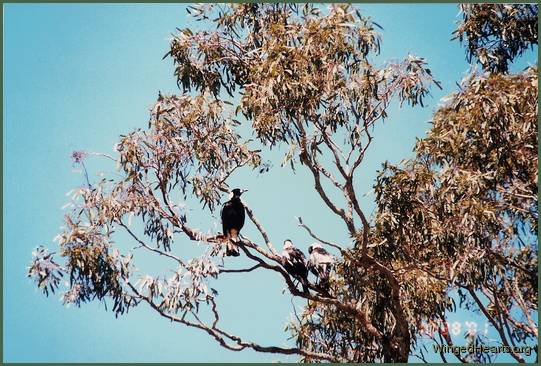7 Tips to Get To Know Your Wild Birds - Part 2
This is one of the first pictures I took of our birds back in 2001 with a film camera. (Any one remember those things that had to be handled carefully and in the dark?)

Here sitting on an old gum tree is Molly the mother magpie teaching juvis Maggie and Cindy to sing. They had the most brilliant voices and loved singing at top volume. This was during my early days of friendship with them.
In today's post we will explore tips 4-7 of getting to know your wild birds.
4. Look and Listen for Cues
Here are some of the kind of things to look and listen for:
- What are the birds doing at the moment?
- Are they distracted by the activities of other birds?
- Were they happily chatting with you when they suddenly without warning flew off behind a tree?
- Did a bird from another species make a funny sound triggering such an action?
- Are the bigger birds chasing hawks? Are they all hiding from eagles in the sky?
- Are the crows and other medium sized birds trying to stop an eagle from landing?
- Are there some new fledgelings on the scene chirping or squawking for their parents attention?
- Is one bird (or more) speaking to you in a different way? What is he or she trying to tell you? You may have to step out, walk about and look around the general area before you get the idea.
- What sounds delight them and what sounds alarm them?
As you observe their behaviour, you begin to build a picture of what happens in their lives and knowledge base expands.
5. Notice Changes In their Behaviour
- How are they acting today? Are they sitting on a different perch?
- Whom are they talking to? Is it someone of their own species or a different species?
- Do they look different? Birds have a body language too. Are they looking scared, annoyed, angry, tired or fed up?
- Is one bird sitting quietly?
- Are all of them sitting quietly? This could be because an elder in the bird community has died and some are in mourning and others are showing respect. You may shake your head in disbelief, but we have seen this happen many times now and know it for a fact.
- Is the bird feeling sick or anxious? Would they like some help?
Ask them to show you. You may have to ask a few times for them to get the idea. It may also take them a while to figure out how to tell you what is happening. As your ability to communicate with them develops , you will find that they will answer you.
In my series - 23 Amazing Facts About Wild Bird Culture - I share what they have shown us along with the stories as examples of how we learned these insights from the birds.
6. Keep a Daily Journal
We've been keeping a daily journal since mid 2002. This is one of the best ways to keep track of what's happening in your birds' lives - it is a record of what you notice and what you learn. The journal does not have to be elaborate. Just record the date and the highlights of the day. In the beginning you'll find that there will be much to write as you'll be lots of new things. Some days will be quieter than others and some days will be full of activities. In the earlier months you'll have so many stories, you'll think you'll never forget. But as the number of birds grow and time elapses, it is very useful to be able to refer to one's notes and check the details. You will be amazed as to how much you will enjoy becoming a backyard naturalist.
7. Look for Wider Patterns and Stories
As you compare activities over the months, you'll see patterns emerging. Some examples of these are:
- Times of days when the birds sing a particular signature song,
- Times of the day when the chicks learn to sing,
- Times when they are talking to clans who are flying over their territory,
- How they behave if someone invades their territory,
- Times they disappear for hours/days at a time - they've gone visiting or touring,
This will tell you so much more than you can ever find in a book.
You will discover that you have been living amidst the most wonderful world around you, that you hadn't noticed before. I can't properly describe this experience. Your home, your garden, your balcony, your window sill opens up like a magical portal.
You always knew that there were birds around and you thought well for them. But now you become aware of them as individuals and families. You become of their community and they become part of yours. You are now connected and living consciously with them.
Friends and readers who have heard our stories and then gone and done it for themselves have confirmed this change and the resulting amazing sense of awe and wonder too. It is truly a transformation.
Ron and I really believe that this transformation is vital to human growth and evolution as well as that of the other species. The birds (and you know from so many stores that is also true of other animals) are also learning more about us humans. We are all becoming better at understanding each other.
Tomorrow I will give you some examples of the 'show and tell' method of wild bird communication. For earlier posts click here.
Cheers
Gitie

 del.icio.us
del.icio.us Digg
Digg Facebook
Facebook Google
Google Google+
Google+ LinkedIn
LinkedIn MySpace
MySpace Ping This!
Ping This! SlashDot
SlashDot StumbleUpon
StumbleUpon Twitter
Twitter Yahoo
Yahoo



